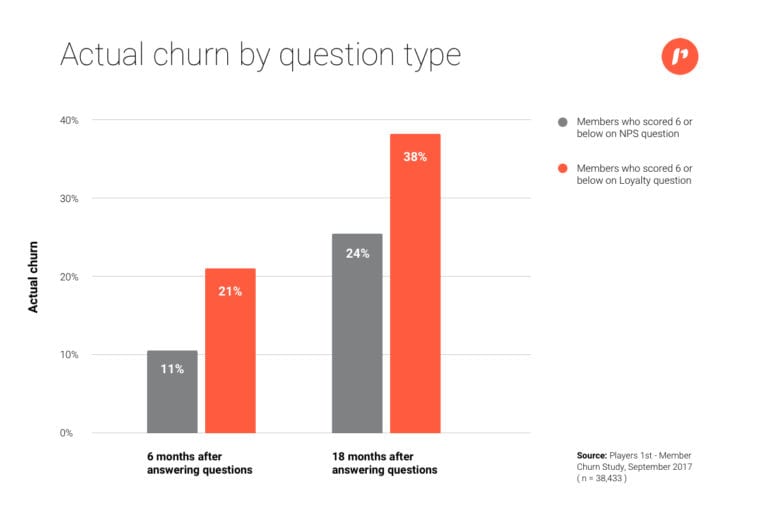Currently, as golf clubs find themselves losing members – some at a critical rate – a vast number of clubs are focusing on recruitment rather than retention, often leading to high churn rates.
We know from our extensive work with a wide variety of clubs that retention really matters to their financial success; as a rule of thumb, it is about five to seven times more expensive to recruit a new member as opposed to retaining an existing member.
A recent study from the Manchester Metropolitan University and England Golf, Value Your Customers, also found that a healthy base of loyal club members is essential to running a sustainable golf business.
Stated loyalty versus actual behavior
The Net Promoter Score has been widely hailed as the one number you need to know in order to grow. Certainly, NPS works and correlates well with players’ stated willingness to recommend and whether they actually do recommend.
However, when it comes to gauging loyalty in golfers in the interest of retaining members our data shows that there is a better question to ask: “How likely is it, that you will still be a member of this club in two years?” The specific purpose of this inquiry is to compare the stated loyalty of members to their actual behavior – the stronger the correlation between the two, the better the question is for predicting actual member behavior.

Based on our analyses, and by integrating feedback gathered through the Players 1st platform with real member churn data, we have observed a higher probability that a given member will have left the club after 6 and 18 months respectively if that member has scored low on the loyalty question as opposed to low on the NPS question. This means that the loyalty question by far outperforms NPS in this regard, and thus it is more effective when it comes to targeting and retaining members who would otherwise abandon their club.
Predict and prevent churn
Significantly, the loyalty question is about twice as effective at identifying members who might leave their club within just six months. This means that clubs can target their retention efforts sooner and more accurately.
Customer follow-up and data-driven action is imperative to good customer experience management, however, too often clubs will realize too late that a given member is close to leaving. Asking the right questions and basing management decisions on a continuous stream of sound member insights, in our experience, will help clubs predict and prevent churn.
“Two out of three members leave their club from preventable causes.”
Data shows that two out of three members who leave their club leave from preventable causes. In other words, their club has failed to identify and satisfy their needs. In general, golfers are a loyal bunch, and in a healthy club, members will usually only leave from unpreventable causes, such as moving to a new home, severe illness or passing away. Two out of three members who leave their club from preventable causes will not relocate to another club, instead, they tend to stop playing golf altogether.
Social integration is the key to retention
Our data shows that the need for social integration, in existing as well as new members, is perhaps the most important aspect for clubs to consider in their retention efforts. This is supported by the Manchester University study which identified several important factors that clubs need to be aware of in order to retain existing members.
These members do not care much about economic incentives, rather they value the experience, club atmosphere, participation, and involvement. We know that existing members require special attention, which can drive up costs of retention over time, however, in the long run, this attention will be worth it, as they can work as ambassadors who will organically attract new members as well as add to club community.
”New members require special attention.”
New members, on the other hand, require a different kind of special attention. We have identified the two most important factors in this regard: becoming better golfers and social integration. Of course, there is a difference between new members and new golfers – ambassadors are great in terms of socially integrating both kinds of new members, but there are many ways to getting players involved and make them feel welcome.
In the case of new golfers, becoming better players is likewise important to their retention. We are currently studying the effects of PGA professionals and their approaches on new golfers, and it turns out that coaches who are attentive and service minded and also contribute positively to club atmosphere attract significantly more customers. The given club, in turn, tends to be more healthy and have higher retention rates as a result of improvements in new player skills and strong social integration.
Listen to the voice of golfers
Knowing what drives loyalty and being able to measure it accurately can help clubs better understand their members and thus retain them.
The purpose of Players 1st is to provide the industry with the insights they need to make qualified management decisions before it is too late. Our vision is simple: to help grow the game of golf. To this end, listening to the voice of golfers is nothing short of imperative.
